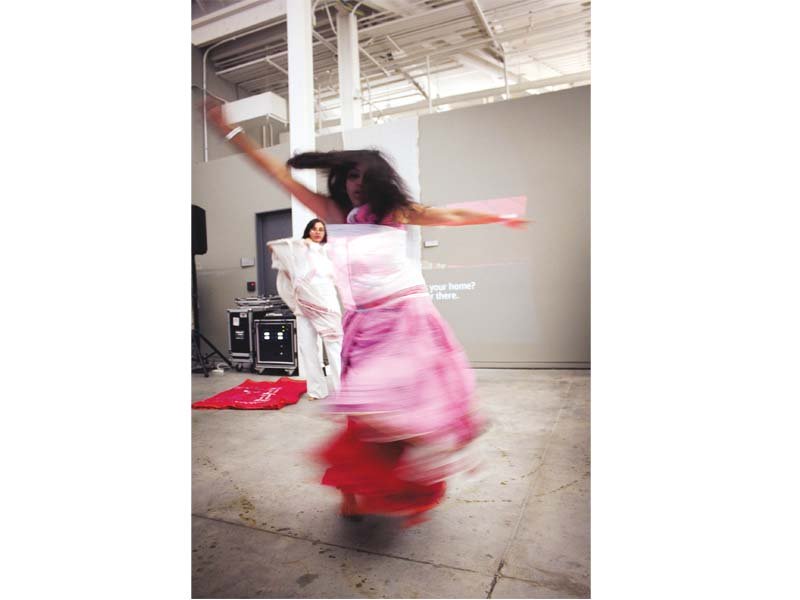
 Monica Jahan Bose’s Sari with audience pledges. PHOTO :Sahar Irshad
Monica Jahan Bose’s Sari with audience pledges. PHOTO :Sahar IrshadThese were among the acts exhibited in ‘Perform(art)ive’, a performance art festival hosted by Twelve Gates Arts, which took place in October at the Drexel University in Philadelphia. The festival exhibited South Asian performance art, a medium often dominated by the Western art world, according to co-curator Atif Sheikh. “I had to look for South Asian, non-Western artists and references,” he said, “And there’s so much out there.” Sheikh said he was inspired by the rich political tradition in South Asia that uses public demonstrations to trigger change, emphasising the role of Sufis and malangs.
“Anyone can meditate and be a Sufi in the privacy of their homes, but people who choose to go out into the streets and dress up and be noticed are performing,” he said.
The festival highlighted several social and political issues like caste oppression, climate change, gender injustice, racism, and queer identities. In each performance, the artist lived the reality of their art.
 Indian artist and lawyer Sumit Baudh. PHOTO : Sahar Irshad
Indian artist and lawyer Sumit Baudh. PHOTO : Sahar Irshad Sumit Baudh during his performance. PHOTO : Sahar Irshad
Sumit Baudh during his performance. PHOTO : Sahar IrshadMonica Jahan Bose’s performance ‘Rising’ used a 216-foot long sari, which she made collaboratively with 12 female cyclone survivors from her village in Bangladesh. “These saris were worn by the women for eight or nine months. They bathed in them, cooked in them, they lived in these saris,” she says.
Indian artist and lawyer Sumit Baudh brought a personal angle to his performance, ‘Yo no soy el’ or ‘I am not him’. He said his involvement in various social movements as a gay Dalit man affected his artwork. “There have been times when I’ve been part of those communities, part of those cultures,” he explained, “There have also been times of disassociation. I am part of this, and in some ways I’m not.” He said his work showed the pursuit of identity through denial, and how marginalised people challenge prejudice by asserting, “I am not what you think I am.”
“Both Sumit and Monica are lawyers. They actually work and live their art. So activism is a part of who they are,” Sheikh said.
Pakistani artist Shahzia Sikander also creates art through social relationships, noting a performance piece she did for the Sharjah Biennial II in 2013. She said she worked with an abandoned cinema in the UAE. The guard of the cinema came from Pakistan and had a special connection with the architecture. “He came as a labourer to build the cinema in 1976. It was pretty incredible to come across someone whose entire existence was still linked to this building. As soon as the building is demolished, he would have to go back to Pakistan,” she said.
 Twelve Gates Arts team for perform(art)ive. PHOTO : Sahar Irshad
Twelve Gates Arts team for perform(art)ive. PHOTO : Sahar Irshad Curators Atif Sheikh and Mir Masud-Elias. PHOTO : Sahar Irshad
Curators Atif Sheikh and Mir Masud-Elias. PHOTO : Sahar IrshadQasim Riza Shaheen, who was not able to attend the festival, remodeled his ‘Misplaced Memoirs’ into an episodic sound piece. Anonymous performers listened and responded to his intimate love letters while blending into the audience, denoting the often silent and overlooked transience of everyday love affairs.
The final performance of the evening was a collaboration between Sikander and Danielle Currica, a Guyanese-American dancer. Sikander’s gold silhouettes of Gopi hair were projected onto the building while Currica danced to Africa Must Wake Up. Currica said she’d never heard of Sikander before the festival. “I found out about the performance last week. The first person I got to speak to was Shahzia and it was amazing to sit and talk to her because she was very genuine and open about her background and her work,” she said. Currica said she enjoyed the multiplicity of Sikander’s work. “The work is able to transform and go through much iteration. It isn’t held to one particular environment,” she said.
 A screenshot from Qasim Riza Shaheen’s video, Lost Passport. PHOTO: Sahar Irshad
A screenshot from Qasim Riza Shaheen’s video, Lost Passport. PHOTO: Sahar IrshadSheikh also stated that it was the eclecticism that made the festival successful. “We touched on many contemporary issues with the artists and their caliber has set the bar pretty high for the next exhibition,” he said.
Iman Sultan is a freelance writer and activist based in Philadelphia.
She tweets @churayl
Published in The Express Tribune, Sunday Magazine, November 15th, 2015.



1732184775-0/BeFunky-collage-(80)1732184775-0-165x106.webp)













COMMENTS
Comments are moderated and generally will be posted if they are on-topic and not abusive.
For more information, please see our Comments FAQ